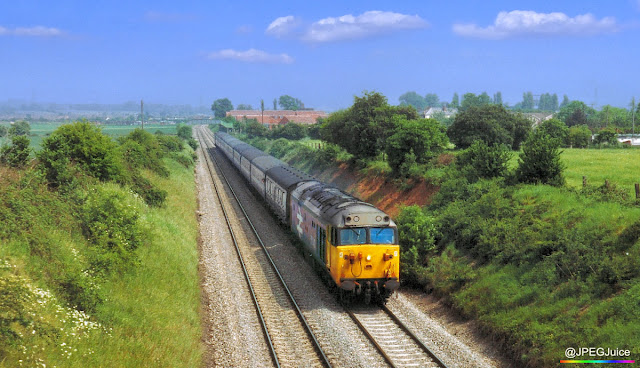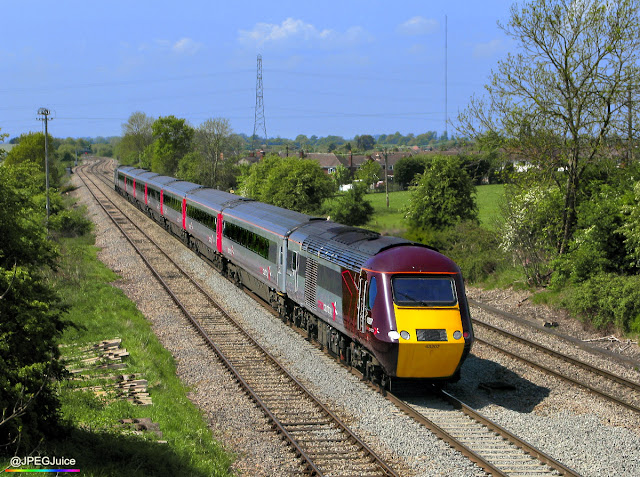Showing posts with label British Rail. Show all posts
Showing posts with label British Rail. Show all posts
Info-Pictorial: ‘Peaks’ on the Birmingham to Gloucester Line
"So post 1975, the 45/1s only had a skeleton presence on the Lickey, while the 45/0s and 46s took care of nearly all ‘Peak’-hauled cross-country runs."

They might seem like a primitive form of power today, but the ‘Peaks’ once represented the cutting edge of rail traction on the Cheltenham to Birmingham New Street line. Indeed, it was a ‘Peak’ whose awesome tractive effort first proved it possible to eliminate banking for northbound passenger trains on the Lickey Incline. Class 45 No. D40’s experimental, heavily-loaded assaults on the 1 in 37 back in 1961, were what persuaded BR that bankers (at the time still steam) could actually be used selectively, rather than religiously.
And the ‘Peaks’ never looked back. Twenty-odd years later they were still single-handedly wrenching rakes of twelve or more up the gruelling gradient without complaint. In this info-pictorial I’m recalling the irrepressible 16-wheeled monsters in the latter phase of their heyday between Birmingham New Street, Cheltenham Spa and Gloucester.
Info-Pictorial: East Midlands Ranger in the ‘Deltic’ Era
"For the final period of ‘Deltic’ operation, starting on 5th October 1981, there were five ‘Deltic’ diagrams left, covering fifteen passenger trains on a weekday."

The primary focus of many an East Midlands Ranger ticket-holder in the 1979 to 1981 period: English Electric's Class 55 'Deltic' diesel. This is 55014 'The Duke of Wellington's Regiment' at Doncaster, on Sunday 26th July 1981.
It was one of the best value weekly area tickets of its time. At an average of less than a tenner between 1979 and 1981 (and less than a fiver for kids), the East Midlands Ranger presented a diesel haulage fanatic with an incredible opportunity to dive into the thick of ‘Deltic’ operation. Imagine that. A full week of intensive ‘Deltic’ haulage for less than a tenner. But that wasn’t all the East Mid offered. There was more. Much more…
History: The Life & Times of Rail Blue
"So, what was the first Rail Blue train? That’s a question no one seems to want to answer. But the candidate spotlight fell on brand new locos and units being built at that time..."

It’s a nostalgic behemoth. Its prevalence on today’s preservation scene attests to that. And yet in its classic form, the Rail Blue livery of corporate British Rail doesn’t have any design features that look spectacularly clever. It appears very, very basic. So why do we care about this grandfatherly livery so much? Is it the colour? Is it some subtle feature that only our subconscious can see? Is it just the almost lifelong familiarity? Let’s explore…
The Class 50 Refurbishment Story
"In response to a question by Modern Railways a few weeks later, BREL Managing Director Ian Gardiner argued that the 'super-overhaul' process could essentially be described as remanufacture..."

The archetypal look of the Class 50, post refurbishment. 50040 Leviathan heads for the South West, at Wychbold, in June 1982.
Believe it or not, it’s now a whacking 40 years since the hushed and experimental beginnings of the Class 50 refurbishment programme. For fans of the type, the scheme’s raft of modifications brought a buzz of excitement, with a new sound, a new look, and a drastic reduction in Class 47 stand-ins on ‘Hoover’ diagrams.
Indeed, it's fair to assume that the greater proportion of today's extant Fifties owe their very survival, in part, to BREL Doncaster’s four-year run of mega-overhauls which gutted and rebuilt every last member of the class. But for British Rail, the programme was part of a much wider quest to stem the rapidly diminishing reliability of the diesel fleet…
The CrossCountry HSTs
"...All but one had been Virgin CrossCountry power cars before the introduction of the Voyagers, and so were really just returning to old haunts."

In 2003, when Virgin Trains announced that their use of HSTs on CrossCountry had come to an end, it looked as though more than two decades of regular IC125 service over the network had passed into history for good.
Demand for the 1970s design icons did, however, persist, and for the next few years Virgin drafted in HSTs on short-term hire to extend capacity when required. But when Arriva won the new CrossCountry franchise in summer 2007, they pledged that the HST would return to daily operation on XC routes. A new era was about to begin for the vintage-yet-still-modern classic. MTU-engined Class 43s in the distinctive late noughties XC livery would become a familiar sight, and remain so for over a decade…
